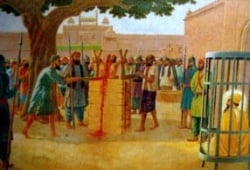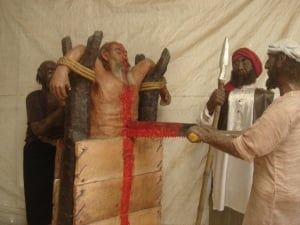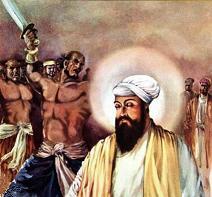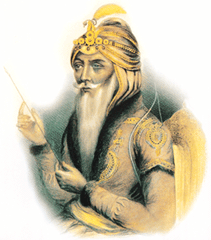Khalsa Panth
Khalsa Panth (meaning: a group of baptized Sikhs) (Punjabi: ਖ਼ਾਲਸਾ ਪੰਥ, khālsā panth) is the theocracy that manages the affairs of the Khalsa. (Khalsa meaning: a baptized Sikh). It refers to the entire group of people who have taken the way of the Khalsa, and hence they are self-managed through democratic votes.
The Khalsa Panth is an evolute from Guru Nanak’s Nirmal Panth - both terms meaning the way of the pure or the holy. It is the way of pure spirituality, unadulterated with ritualism and free from the clutches of priests. The term Khalsa has another connotation also. In the revenue records in India during the Muslim rule, this term signified crown lands, administered by the king himself without the mediation of Jagirdars, etc. Metaphorically employed in the Sikh parlance, the term Guru ka Khalsa means the guru’s very own, unmediated by masands.
The term acquired a more specific connotation after Guru Gobind Singh introduced Khande-di-pahul (initiation with a double-edged sword) in 1699. Since then, all those thus initiated have been collectively designated as the Khalsa Panth.
After the line of corporeal gurus was brought to an end by Guru Gobind Singh, the Khalsa Panth was installed its own leader under the abiding guidance of Guru Granth Sahib. Since then, the Khalsa have evolved into a kind of spiritual commonwealth - a spiritually welded collectivity which awakens in each individual spontaneous discipline as well as disciplined spontaneity (Rehat).
Setting ideals for life: There have been some contrasting ways of setting ideals of life. One is the way of hedonism, or pursuit of sensual pleasure advocated by those consider this life as a sole opportunity for enjoyment. This outlook is epitomized in the famous lines of Babur.
Enjoy life’s pleasures to the full, for this world is never going to be again for you.
or, by the apparently hedonistic meaning of Omar Khayyam’s verse which has been translated by Fitzgerald as:
"Dreaming, when dawn’s left-hand was in the sky,
I heard a voice within the tavern cry, awake my little ones, and fill the cup, before life’s liquor in it’s cup be dry."
This is the materialist way, looking for material gain, amassing wealth and power, lavishly indulging in sensuality. It is the way of pravirti or involvement in the world.
Contrasted with this has been the way which considers the world an illusion and its materiality a mirage. Hence, it advocated withdrawal from the outside and seeking the joy of self-realization within.
Even when one chooses to withdraw from the world and concentrates within, the world may still interfere with one’s spiritual pursuit. In that case, one has two choices. One may run away from the world, i.e. renounce the world. It is the way of nivirti or renunciation. Alternatively, one may choose to become so strong that no one dare interfere with his spiritual pursuits.
The Khalsa outlook of spirituality considers both involvement (pravirti) and renunciation( nivirti) as extremes and advocates the middle path. The Guru’s word affirms.
Involvement as well as renunciation are stubborn obstinacies.
Dharma, somewhere in the middle, stands as the real guide.
- Malhar Var: M.1.p.1280.
The middle path is: continuing to be in the world but staying there dis-attached, just like the lotus flower which grows out of mud unblemished by it.
The Khalsa point of view, since it does not approve of renunciation, prescribes valour as a safeguard against interference from others. However, this has to be disciplined valour, compassionate valour and an altruist valour; not one which is self-willed and tyrannical. In this context, the Guru ordains:
You shall not terrorize anyone nor shall allow anyone to terrorize you.
-Slok. M.9 p.1427
Such, then is the "valour" prescribed for the Khalsa.
Two Pillars of the Khalsa Spirituality: The twin pillars of the Khalsa spirituality are (a) Naam, the vehicle of inner spirituality and (b) Kirpan, the symbol of outer spirituality or valour. It would be useful to consider these two in some detail.
Naam: Naam is the foundation stone of Sikh spirituality. Naam has usually been translated as "Name", implying God’s Name. However, "Name" does not fully convey what Naam comprehensively means as a metaphysical term in Sikh theology. It is very much more than God’s Name, though it is God’s Name as well.
The Guru says:
Blessed by Naam I live - my body and soul blossom forth.
- Slok M. 5 p. 1429
Here Naam appears to mean the principle of life. Again, the Guru affirms:
Naam and egoism are mutually opposed - the two cannot exist together.
And again:
Naam sustains all living beings.
Sustains also all Regions of the Universe.
- Gauri M:5 p. 284
Here Naam is the Divine Sustainer. Naam yet has another connotation:
The Lord of Himself created himself
Himself he assumed the Naam;
In the Second place he created Nature
And adiding in it observed it with favour.
- Var Asa M. 1 p. 463.
Here Naam stands for Divine creativity, coming as does between God Himself and His creation.
Let us now consider what Naam Japna is, which is a prescribed spiritual praxis. Japna is usually translated as "muttering". But Naam Japna is not mechanical muttering of God’s Name. Guru Amar Das says:
Everyone has "Hari!" on his lips;
very few have him in the heart.
They alone in whose heart he abides attain liberation.
- Vadhans M.3 p. 565
There are thousands upon thousands of Naam-mutterers who get nowhere. They seem to be looking for peace. But what kind of peace do they get, if they get at all? It would be dead peace, not living peace. Living peace is characterized by creativity. It is not just getting absorbed in the formless, unknown, infinite. It is making the void alive with a myriad dynamic forces and forms. Mechanical muttering may lead to mental abstraction in which all dualities and all opposites come to an end. It would be uncreative peace - a spiritual inanity.
Naam Japna in the Khalsa terminology is a process creatively inspired. It is dwelling in Him with one’s entire Being. It is practicing the presence of God. It is feeling Him around - He who sustains us, supports us, provides for us, takes care of us, loves us, showers His gifts on us unasked, and having given never repents. It is He
Who has dispersed Himself as Love here there and everywhere.
- Jaap Sahib
Remembering Him with loving gratitude is Naam Simrin or Naam Japna. It is to be aware of God at our back. It is remembering Him as we remember our absent friends - with love and expectation. It is inebriation with love - madly inspired.
The key factor in Naam japna in dhyan (focused attentively). In the liturgical prayer (Ardas) the ardasia time and again invites the congregation to focus their attention and call on "Waheguru!" Sustained attention is meditation. Naam Japna or Naam Simran, then, is the specific Khalsa way of meditation. Naam is the Guru’s gift - a special gift to his disciples.
Everyone utters the Naam by his lips.
Those alone who follow the guru really attain Naam.
- Malar M.3 p. 1262
The Guru is essential for Naam. But the Guru need to be a corporeal Guru. The real Guru is his precept or bani. The embodiment of the Guru’s spiritual precepts is Sri Guru Granth Sahib which, therefore is the source of Naam.
Meditation of Naam leads to a spiritual implosion, when torrential cascades of energy are released within. This energy may appear as nad (sound) or joti (light). Sound and light are interchangeable modes of energy - as has lately been demonstrated by the scientific experiments on sonoluminesence.
Guru Arjun Dev records evidence of this in a Sloka:
The sparrow chirped. The dawn broke out. A myriad streams unrolled.
Creation of wondrous sights the saints witnessed through absorption in Naam.
- Gauri Var M. 5 p. 319.
In this slok, the chirping of the sparrow signifies the nad and breaking of the dawn signifies joti. Those who meditate on Naam are familiar with these experiences as also with unrolling of a myriad streams of unstuck musicality.
Kirpan: Kirpan (the sword), also called Sri Sahib in the Khalsa parlance, is the second symbol of the Khalsa spirituality. It is a symbol of divine dynamism. God is active all the time. everywhere. I sometimes think, God is not a name, but a verb. He is superdynamic and Sri Sahib is the symbol of his superdynamism. While Naam represents the ingoing side of nature, Sri Sahib represents its outgoing side. It stands for the Divine Power - the Divine Sword. Guru Gobind Singh leaves no doubt that it is the Divine Sword when he describes it in the following terms :
Hail to you, Creator of the Universe,
Protector of the world, My own sustainer,
Hail to you, the Sword (Divine)!
- Bachitra Natak - 39
Although Jesus Christ is believed to be the great pacifist, yet he said; "think not that I came to send peace on Earth. I came not to send peace but a sword." (Matthew X 34). While "peace" is the stilling, calm, negative condition, the "sword" is the outgoing or positive condition. All that is evil or obstructive has to be destroyed before reconstruction is possible.
That is why Guru Gobind Singh says:
At first You made the double-cutting sword,
And then You shaped the whole world.
- Chandi di Var 2:1
Here, like Naam, the double-edged sword (Khanda) also represents Divine Creativity. The sword of the Khalsa is then the Divine Sword which destroys evil. It is not unsheathed in anger, or out of vengeance. It rises only out of compassion. It does not take away life, but protects it. It does not slaughter, it only saves.
One is reminded here of a fascinating story from the history of the Khalsa. Baba Sahib Singh Bedi was a respected leader of the Khalsa - so highly respected that the natural choice to anoint Maharaja Ranjit Singh to kingship fell on him. The story, however, pertains to his earlier days when the Baba had been proclaimed as a rebel by the Mogul rulers and he was wanted dead or alive. That was the time when he had taken sojourn in a forest. An army officer, Din Mohammed by name, got scent of him and started searching the forest. Finally he found the Baba but most unexpectedly was struck by the Baba’s extraordinary compassion, his God-fearing fearlessness and his exemplary hospitality. So, instead of killing him or taking him prisoner, he respectfully took leave of him.
Hardly had he proceeded a few steps after leaving the Baba’s cottage that he noticed three Pathans dragging a young girl towards their waiting camels. It did not take him time to recognize the girl as the deaf and dumb young lady who was living with the Baba and had been his co-host the previous night. He had learnt from the Baba that this handicapped girl when only an infant was deserted by her parents, and abandoned in the forest. The Baba found her and in compassion brought her up.
Seeing her in distress, the officer pounced upon the Pathans but being outnumbered he was overpowered. However, hearing the noise, the Baba came out and fell upon the Pathans. One of them he seized but the other two fled scared. The Baba threw the seized Pathan on the ground and mounting on his chest said: "You attempted on the modesty of an innocent girl. Your punishment cannot be anything short of death, so be prepared!" The Pathan, upon this, employing the foulest language not only hurled coarse abuses on the Baba but also spat on his face and said. "Now do what you like". The Baba got down from his chest saying, "I would surely have killed you, but now I spare you, lest it be construed that I killed you out of vengeance after this insult. If Din Mohammed has to square any accounts with you, I leave you into his hands."
So, in addition to Naam as the prime symbol of Divinity for the Khalsa, a complementary symbol of the Divine is also Kirpan or Siri Sahib which has been referred to as "all-steel" (Sarab-loh), "all-time" (Sarab-kal) and "supreme mortality" (Maha-kal). Guru Gobind Singh, in an invocative verse, said :
In this Kali Age our great reliance can only be
On the mighty arm of the supreme Kala.
- Bachitra Natak 1292.4.
The Fusion of Naam and Kirpan: The fusion of Naam and Kirpan is witnessed in the initiation ceremony of the Khalsa called Khande-di-Pahul (initiation with the double-edged sword).
Designed by Guru Gobind Singh, this ceremony was first introduced on the Vaisakhi day of 1699. In a steel bowl he stirred sweetened water with a double-edged sword while reciting gurbani (Guru’s word). Thus he prepared Amrit (nectar) to he partaken by the five beloved Sikhs (Panj Piarey) who had volunteered to offer their heads to him to the call of his sword. They were thus the twice-born, with whom the Khalsa Panth came into being. After they had been initiated, the Guru requested them to initiate him in the same manner. Thereafter many thousand followed to be so initiated. It is thus that the Khalsa Panth came into being through the joint-spirit of Naam and Kirpan. This Khalsa was eulogized by the Guru himself saying:
- The Khalsa is my own special form
- Within the Khalsa I’ll ever abide,
- The Khalsa is the life of my life;
- The Khalsa is the breath of my breath.
- The Khalsa is my worshipful lord.
- The Khalsa is my saintly kinght.
Chardi Kala: Initiation through the fusion of the spirit of Naam and Kirpan, not surprisingly, generated a higher level of consciousness among the Khalsa which has been designated as Chardi Kala. Chardi Kala is a subtly composite concept. Though it is commonly translated as "high spirits" or "high morale", in fact, it signifies much more. It stands for a perennially blissful spirit, aperpetual state of certitude based on Naam. It is the everlasting spirit of valor which makes light of all hardships and handicaps. It is that spirit which can prompt one, who only gets mouthful of grams to eat, to declare that he or she is eating almonds; or leads one to describe death as an expedition to the other world. In Chardi Kala there is confidence in the ultimate victory of truth over falsehood and of good over evil. Perpetual readiness (tiar-bar-tiar) is also a characteristic of Chardi Kala. It is in action that a man of Chardi Kala exists - not just in pious resolutions. He pursues the ideals that he cherishes, makes no noise about them, but proceeds to another, and yet another.
In short, Chardi Kala is not just high spirits, but also unwavering faith in Divine support, sublimity of action, and certainty of moral victory. One of the most memorable proclamations of Chardi Kala was made by Guru Gobind Singh during the most desolate of his days in a friendless forest sojourn. He said:
- With Three O Lord! I’d prefer to sleep on a straw bed,
Accurst is living with those whom one loves not.
Khyal: Shabad Hazare
The fundamental premises of the spirituality of the Khalsa are unique in the history of world religions. So too is the character of the consciousness that it generates. It resolves a number of basic paradoxes, such as those between participation and renunciation, compassion and courage, valour and non-violence, justice and forgiveness. It unfolds disciplined spontaneity and an unwilting blissful confidence (Chardi Kala) in the Khalsa.










